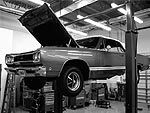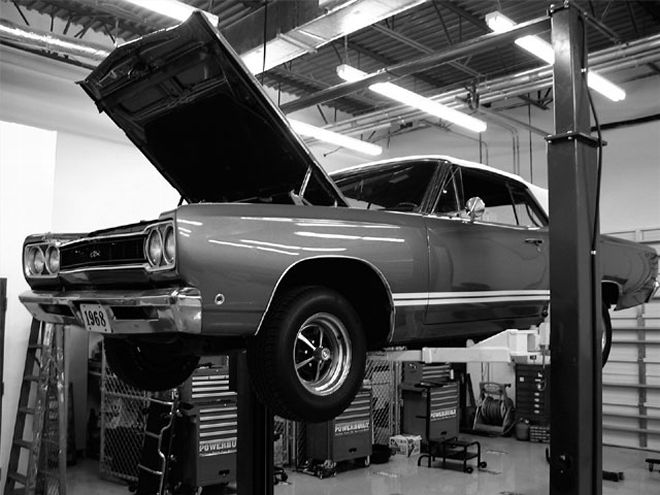

What happens when 440 ci of Holley 850-fed big-block tries to suck fuel from a 5/16-fuel line, a 37-year-old tank and pickup? Fuel starvation! That's exactly what brought our thirsty GTX clone to our Tampa shop for some fuel-system upgrades.
We've all either had this problem or known someone else who has. It's called fuel starvation, and it will cripple everything from your stock 318 to the most potent big-block you can bolt between your framerails. The symptoms of fuel starvation-also commonly referred to as vapor lock-can be erratic and hard to diagnose, but most can be traced back to your Mopar's stock and usually inadequate fuel system.
The first thing you have to understand about your Mopar's fuel system is that it was designed with both function and cost in mind. That's why all cars built with nonperformance engines came with a 5/16-inch pickup and fuel line. It cost less to manufacture, and it performed adequately, delivering fuel to the slant six it was designed for. If you're lucky enough to own a performance-model Mopar, you have the luxury of a 3/8-inch fuel line and pickup; better, but still marginal for a true performance application.
There are two inherent problems with the factory fuel systems. First, if you add a performance cam, a four-barrel carburetor, headers, or, even worse, swap a 440 for that 318, your car's fuel line and pickup won't flow the extra fuel necessary to keep your engine running at high rpm, even if the system is in perfect shape. Second, time takes its toll on all of your factory fuel-system components. In addition to dirt ingested when the fuel cap is off, condensation forms inside the fuel tank and a certain amount of water runs through your car's fuel lines, causing corrosion to form inside the tank, pickup, and lines. Having to change your fuel filter more often than you should is a clear indication that your tank and lines have a significant amount of rust and/or dirt in them. What does rust do to the inside of your fuel tank and lines? It reduces that marginal 51/416-inch pickup and fuel line, sometimes to the point that the car will starve for fuel at high rpm, or, in the worst cases, it's so bad that the car will barely do more than idle. Corrosion in the tank will also clog the sock on the end of the pickup, preventing fuel from leaving the tank at all. The end result is the same, the engine starves for fuel and won't deliver the performance it's capable of.
There are numerous "fixes" for fuel starvation problems, including more powerful mechanical fuel pumps, the addition of an electric pump, rerouting of fuel hoses away from heat, cool-cans, and the like, which are really more like a band-aid that cover the problem up instead of addressing the cause. To ensure proper fuel delivery you have to begin with the tank, the pickup, and the fuel lines.
Our '68 GTX clone suffered from the classic symptoms of fuel starvation. it would run cleanly at an idle or cruising down the highway, but when run at wide-open throttle, it would suck the carburetor's float bowls dry, running out of gas at the top of each gear. Our new mechanical fuel pump has the capacity to pump over 70 gallons per hour, which is more than enough for our application, so we knew our restriction was before the pump. Since our car began life as a 318-powered Satellite, it came standard with the 5/16-inch pickup and fuel line. From the looks of the tank in the car, we're guessing it's also the factory piece and has never been removed or cleaned. This is a street application, and we wanted to keep things looking stock, so a fuel cell and custom fuel system was out of the question. We also didn't want to spend a lot of time cleaning, repairing, and modifying our existing tank, pickup, and line for what could be a marginal gain, so we called AllStar Musclecar Parts to see what kind of upgrades are available for our '68 B-Body. The guys at AllStar were great and gave us several options, the best being a new tank, pickup, and fuel line from Quanta Products. We ordered these parts from AllStar and had them in our hands a few days later.
The Quanta tank is made from corrosion-resistant Ni-Terne steel, has a three-year warranty, and is double pressure tested to ensure quality control. The tank looks great, and the only way to tell it's not factory is that the quality is actually better than the stock tanks we've seen. The most impressive part of the Quanta fuel system is that they manufacture a pickup and prebent one-piece fuel line using 1/2-inch stainless steel. That's right, a 1/2-inch pickup and fuel line that fits and looks like factory (except for the size, of course). You may be thinking, even a pretty stout 440 doesn't need a 1/2-inch fuel line, and you're right, a 3/8-inch line would suffice. We, however, are thinking, With a 1/2-inch fuel line, we can add that extra carburetor, blower, nitrous kit, or hellacious race motor down the road and not worry about fuel delivery! Even nicer than the quality of the products was the ease of installation-the tank, pickup, and line fit and worked perfectly, and the entire job took just over four hours.